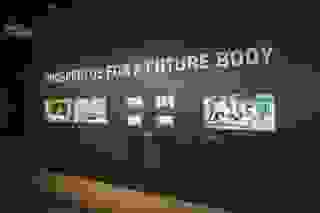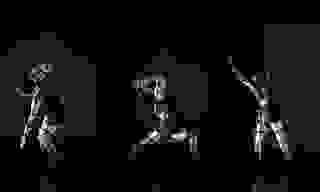


Can we design future memories for the body? Is the body itself an apparatus for remembering cultural processes?
Prospectus for a Future Body proposes new perspectives on how the body remembers and invents technological narratives. Central to the project is the study of body movement in dance: how can it evolve, adapt, or recondition to possible futures? The project is a series of experiments in various forms of video scenarios, workshops, live demonstrations, and performances.

"Prospectus for a Future Body, began while he was a student at London’s Royal College of Art in 2011. Ka Fai developed a number of performances and demonstrations that explore the potential of technology to remember, recreate, and “store” movement. Translating those “memories” back to the body via wired, electrical impulses, Ka Fai is redefining in the process traditional relationships between choreographer, dancer, and audience. He breaks down his investigation into several strands: creating a “library of movements” that are digitally designed and triggered; examining muscle memory and programming; and analysing the possibilities for choreography and movement-mapping when digitally controlled by forces external to the body. Taken as a whole, Prospectus for a Future Body questions whether we can design “future memories” for our bodies, and understands the body as a site of access—through actions designed and translated from external composer to the muscles of the performer—for moments that have passed or are yet to come.”
Paola Antonelli, Senior Curator of the Department of Architecture & Design MoMA - The Museum of Modern Art, New York.






Eternal Summer Storm explores the concept of muscle memory transfer as an alternative form of interactive cultural continuity. This concept prototype speculates on a future digital library of body movements or dance techniques that can be experienced beyond audio-visual conventions. Eternal Summer Storm attempts to recreate legendary Japanese dancer Tatsumi Hijikata's Butoh dance choreography and experience in "A Summer Storm" (1973) from archival footage.
Bionic Movement Research is a collection of experiments on the process of designing digital muscle memory for the body. Inspired by Luigi Galvani's discovery in 1780 of animal electricity in the human body, these experiments appropriate the techniques of electrical nerve stimulation to choreograph artificial muscle contraction and body movement.
SynchroMetrics is a choreographic study on the experience of synchronicity. The experiment presents a dialogue between natural and digitally stimulated choreography, in an attempt to interlace the conceptual connections of the mind with a technological influence on the body.
Notion is a demonstration performance exploring the possibilities of muscle memory implant as a digital form for recording, playback and real-time mapping of movement-based technique. Inspired by the evolution of dance history in the last century, the performance attempt to install digital muscle memory implants from a selection of iconic dance movement vocabulary into a body as it learns, adapts and recreates within the multiplex of kinesics expression.





Prospectus for a Future Body was presented at The Israel Museum Jerusalem Israel, Museum of Contemporary Art Tokyo, Tanz Im August Festival Berlin and Singapore Art Museum, Singapore
Notion Dance Fiction is a production by Choy Ka Fai, developed with the support of National Arts Council Singapore, Design Interaction, Royal College of The Art London and STUK Arts Center Leuven. Special Thanks to aRco Renz.